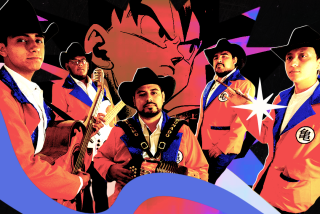A sword-swinging manga with lots of souls
- Share via
Although HE’S the hero of one of the most popular manga series in the U.S. and Japan, Ichigo Kurosaki has little in common with conventional good guys. He’s a scrawny high school student whose spiky orange hair attracts a lot of unwelcome attention. (It’s that color naturally; people call him “Strawberry,” but “Pumpkin” would be more like it.) He’s not the easiest guy in the world to get along with: “I’ve got a bad temper, so I get in fights easily. If the faculty hassles me, I usually mouth off. Then they say I have a behavior problem and the whole thing snowballs.”
But people on both sides of the Pacific love Ichigo: Tite Kubo’s manga “Bleach” has sold more than 40 million books in Japan and topped sales charts in America. “Bleach” has also been adapted into a long-running animated TV series, two direct-to-video adventures, three theatrical features, a rock musical and several video games.
Since he was a child, Ichigo has been able to see the spirits of the dead.
Mysterious explosions in his neighborhood that only he hears lead him to Rukia Kuchiki, a Soul Reaper charged with destroying soul-eating monsters called Hollows. When she’s injured in a battle with a particularly nasty Hollow, Rukia gives her power to Ichigo. The spiritual energy that allowed him to see spirits enables him to serve as an effective substitute Soul Reaper.
But giving power to a human is a capital offense for a Soul Reaper. Rukia is arrested and returned to the Soul Society to await execution.
Supernatural products dealer Kisuke Urahara tells Ichigo he might be able to save Rukia.
As Ichigo learns to control his powers, his friends Sado “Chad” Yasutora and Orihime Inoue prepare to accompany him under the tutelage of Mr. Yoruichi, Urahara’s talking cat.
The Seireitei, the realm of the Soul Society, is a guarded preserve where jealousies and rivalries fester among the members of various squadrons. Urahara enables the rescuers to cross the dimensions to the Seireitei just as strife is breaking out.
Kubo imbues his characters with a depth that’s rare in American comics. When Ichigo was a small boy, a Hollow killed his mother. Ten years later, he’s still haunted by guilt, convinced he somehow failed in his duty to protect her. Now that he’s been given a Zanpak-to, a sword that can kill a Hollow, and the power to wield it, he’s dedicated himself to preventing anyone else from suffering the way he and his family have: “I’m not Superman. I can’t protect everybody in the world. But I don’t just want to protect the few who I can hold in my arms. I want to protect as many people as I can.”
A good hero needs interesting villains, and Ichigo and his pals fight a bizarre parade of Soul Society officers that make Dick Tracy’s foes look like the boys next-door. One sadistic captain sports a black mask with strange knobs at the ears and chin and a sweeping hat; another has geometric tattoos over his eyes that reach to his hairline. Some of the Hollows look like the misshapen fossils of unsuccessful dinosaurs.
Most of the characters fight with swords, but those also take fantastic forms -- a long chain of hooked blades or a flying cloud of shards that suggests the petals of a murderous flower. Ichigo’s Zanpak-to is inhabited by a powerful spirit who becomes an important ally.
“Bleach” is an unusually cinematic manga. Kubo “cuts” between small close-ups of a villain’s smile, a hand reaching for a weapon or a foot taking the decisive step to initiate a deadly attack and large drawings of weapons striking targets, swords clashing and heroes posed dramatically against the sky. Masses of sharp, staccato lines energize Kubo’s drawing, and he juxtaposes the line work with large areas of solid black or white to heighten the drama. When Ichigo sulks or another character behaves childishly, Kubo draws them in a simple, cartoon-y style that reflects their immaturity.
“Bleach” is an ongoing saga. Volumes 1 through 20 encompass the first story arc -- the rescue of Rukia and the revolt within the Soul Society.
In Volume 21, Kubo introduces new characters, new challenges and new threats, and his imagination shows no sign of flagging.
Knowing there are more adventures for Ichigo and his friends is like knowing there’s more chocolate cake before you’ve finished your first slice.
Charles Solomon’s most recent book is “Disney Lost and Found: Exploring the Hidden Artwork From Never-Produced Animation.”
--
On the Web
For a profile of manga author Tite Kubo, please go to latimes.com/bleach.
More to Read
The biggest entertainment stories
Get our big stories about Hollywood, film, television, music, arts, culture and more right in your inbox as soon as they publish.
You may occasionally receive promotional content from the Los Angeles Times.










